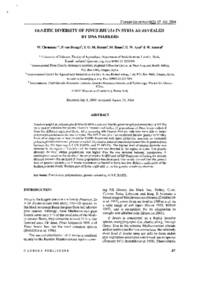Genetic diversity of Pinus brutia in Syria as revealed by DNA markers

Authors:
Random amplified polymorphic DNAs (RAPDs) and amplified fragment length polymorphisms (AFLPs) were used to estimate the genetic diversity between and within 21 populations of Pinus brutia collected from five different regions of Syria. After screening 400 Operon Primers, only nine were able to detect polymorphism between the tree samples. The AFLP analysis also confirmed the low genetic variability. Even after digestion of monomorphic RAPD fragments with three restriction enzymes, no increased polymorphism between samples was revealed. The total number of identified polymorphic fragments (loci) between the 311 trees was 111 (74 RAPDs and 37 AFLPs). The highest level of genetic diversity was detected in the region of Latakia and the lowest one was detected in the region of Idleb. The genetic diversity detected within populations was higher than the one detected between populations. A dendrogram based on the results of the polymorphic RAPD and AFLP fragments reflecting the genetic distance between the analyzed P. brutia populations was developed. Our results showed that the general level of genetic variability in P. brutia populations collected in Syria was low. Relative uniformity of the landscape in the North Western part of Syria might add to the low genetic variability observed
